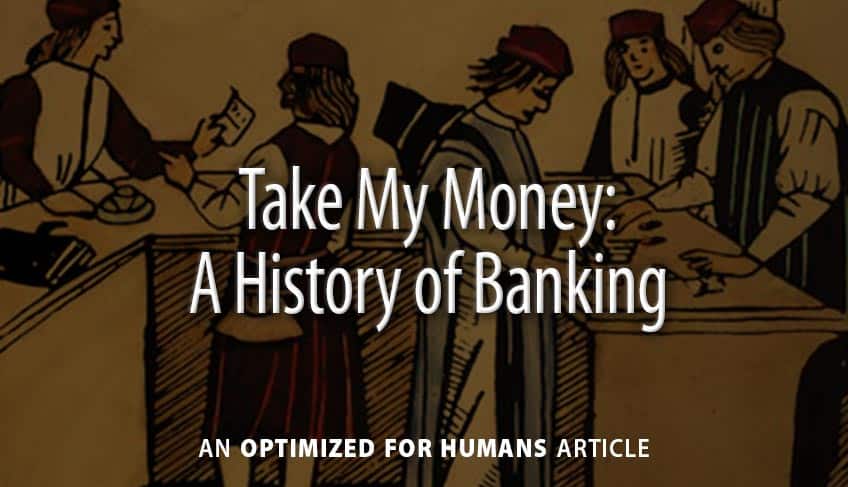
B Y T O M T O R T O R I C I
A few posts ago, I introduced the idea of ‘Branded History.’ The example I shared was a historical account I had written about the origins and development of soap. It culminated in the story of my client’s detergent-making business, essentially putting it in the flow of history.
This seemed to make the CEO feel he had made a significant contribution to his field. It was also a unique marketing approach that he enjoyed sharing far and wide.
Today I’d like to offer a second example, which I included in the annual report of a Middle Georgia community bank. Read on; who knows what you might learn.
A History of World Banking
Thousands of years ago, people who had surplus wealth not needed for daily living kept it in the form of gold. But the problem with gold was that thieves could find and steal it. The only safe place to store the precious metal was the local temple, with respected, responsible priests on hand to deter threats.
While the gold just sat there, a growing system of commerce needed money, at least temporarily, to expand trade operations. Temple priests eventually made the connection, and started loaning the gold entrusted to them to emerging trade companies. The concept of banking had arrived.
The Greeks and Romans later institutionalized banking and standardized financial transactions. Early banks handled local deposits, loans, currency exchange, and the examination of coins for purity and weight.
Around the 13th century, an important innovation emerges: ‘bills of exchange’ that allowed people to make payments in one city while offering credit of the same amount in another. This precursor to modern bank branches relieved customers of having to transport sacks of heavy coins.
Unfortunately for banks, the idea of charging borrowers a fee back then was considered morally questionable. Northern Italian money-lenders got around this by presenting interest as a voluntary amount the borrower paid in exchange for the risk taken by the lender. This set the stage for the banking industry to profitably grow.
A History of U.S. Banking
There were no local banks in colonial America; companies used the well-established European banking system. Or neighbors simply lent money to each other.
After America established its independence, banks were chartered to lend funds to entrepreneurs looking to build factories. Locally-made products relieved the new country’s dependence on Europe for all kinds of items. Bank charters required the approval of state legislatures, and overall these early banks were financially sound, helping to build trust in the system.
By the early 1800s, bank charters no longer had to be approved by legislators – new banks simply met certain requirements to open their doors. This ‘Free Banking’ system led to the dramatic growth of banks, to support the dramatic growth of the American economy. However not all of these were well run. Chronic abuses and bank failures, especially in free-for-all western states, prompted stronger regulation and ongoing oversight to restore consumer confidence.
While the U.S. Treasury issued coins back then, individual banks issued their own paper money. Known as banknotes, or scrip, this currency was redeemable for gold or silver — in theory, at least.
In 1865, in an effort to get state-chartered banks to submit to new supervision as federally chartered banks, the U.S. Government began taxing their scrip. Banks responded by shifting to ‘demand deposit accounts’, now known as checking accounts. Their monthly fees also handily provided a new source of revenue.
The banking industry grew, at least until the misery of the Great Depression, when banks either failed or were barely functioning. Among President Franklin Roosevelt’s bold reforms to once again restore public confidence was the FDIC deposit insurance program.
A History of Georgia Banking
Back in cotton-growing Antebellum times, most business and trade activity centered around port cities. Which is why Savannah, Augusta (on the Savannah River), and Charleston were also the first banking centers in the South.
The prosperity of banks depended on the current price of cotton; the smaller the crop each year, the higher the cost of each bale. Southern cotton was so big at the time that it was the chief export item of the United States.
As the Industrial Revolution took hold, the first bank in Georgia to have widespread economic impact was The Georgia Railroad and Banking Co. The progressive Augusta firm started as a railroad builder in 1833; its banking division was chartered 2 years later. However, the banking side turned out to be more successful than the railroad side. After the Civil War, they were one of the only banks that honored savings that had been deposited as Confederate scrip. Through a series of mergers through the years, the bank lineage still exists.
Throughout the 1800s, while larger banks remained in larger port cities, smaller locally-owned commercial and savings banks, often family owned, started emerging in Georgia towns. In 1831 the Bank of Hawkinsville opened for business as a personal venture by wealthy General Hartwell H. Tarver. In 1872, Hawkinsville Bank and Trust Company, a larger and better-capitalized institution, brought broader economic strength to the Hawkinsville community.
A History of SunMark Community Bank
The year was 1949. Bing Crosby was on the radio. Bob Hope was in the movies. And in Hawkinsville, Georgia, a businessman and farmer named R.D. Buchan was unhappy with his bank.
So he started his own bank. Managed by EVP D.L. Williams, The Pulaski Banking Company served other local businesses and farmers. Hawkinsville was thriving as the transportation hub of the still-bustling local cotton trade. Mr. Buchan was right about the town’s need for a second bank; by the end of its first fiscal year, a healthy business in loans helped assets grow to $452,021.05.
The bank boasted the area’s first drive-thru window in 1960, with a teller named Jeannette Ford. Mrs. Ford stayed, learned, and eventually became bank president – only the second female in Georgia to hold that title. Mrs. Ford was also the first president of The Pulaski Banking Company to work on-site directing bank operations.
In 1977, the bank moved from its traditional Greek-columned bank building to sleek, modern headquarters. Two decades later, the bank further modernized, and reinforced its focus on the community, by changing its name to SunMark Community Bank.
New banking laws in 1995 offered the opportunity to branch out in the growing city of Warner Robins. To serve additional families and businesses, branches in Bonaire and Fort Valley opened in 2001. The growth continued in 2016 with a new branch opening in Perry.
Throughout the economy’s ups and downs over the years, the bank has always remained well-capitalized and well-maintained, enabling it to help customers get through tough times. SunMark has also always been an active supporter of its communities, beginning with R.D. Buchan’s bequeath of a scholarship fund to help the children of local workers attend college.
If you know a company that wouldn’t mind being seen as a legacy within their industry, maybe I can write a Branded History for them too. Ping me at tom@tomtortorici.com
Share It:
 About the Author: Tom Tortorici is an Atlanta copywriter and web content writer who helps companies make a genuine connection with their audience. His classes and conference presentations have focused on how writing, strategy and design can work together to grab attention and interest even among readers with short attention spans. In addition to working directly with businesses, Tom regularly partners with web designers and marketing agencies.
About the Author: Tom Tortorici is an Atlanta copywriter and web content writer who helps companies make a genuine connection with their audience. His classes and conference presentations have focused on how writing, strategy and design can work together to grab attention and interest even among readers with short attention spans. In addition to working directly with businesses, Tom regularly partners with web designers and marketing agencies.
All Posts/Subscribe >
Info for Businesses >
Info for Designers/Agencies >
Tom Tortorici Inc. | Tom@TomTortorici.com | 770-934-7861 | 3101 Rockaway Rd | Atlanta GA 30341

